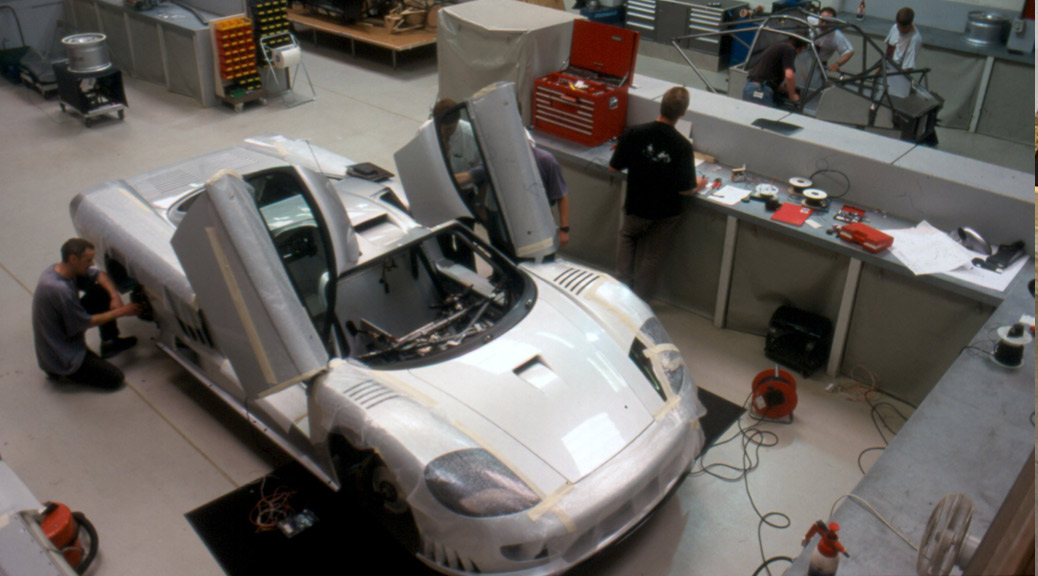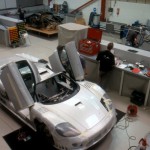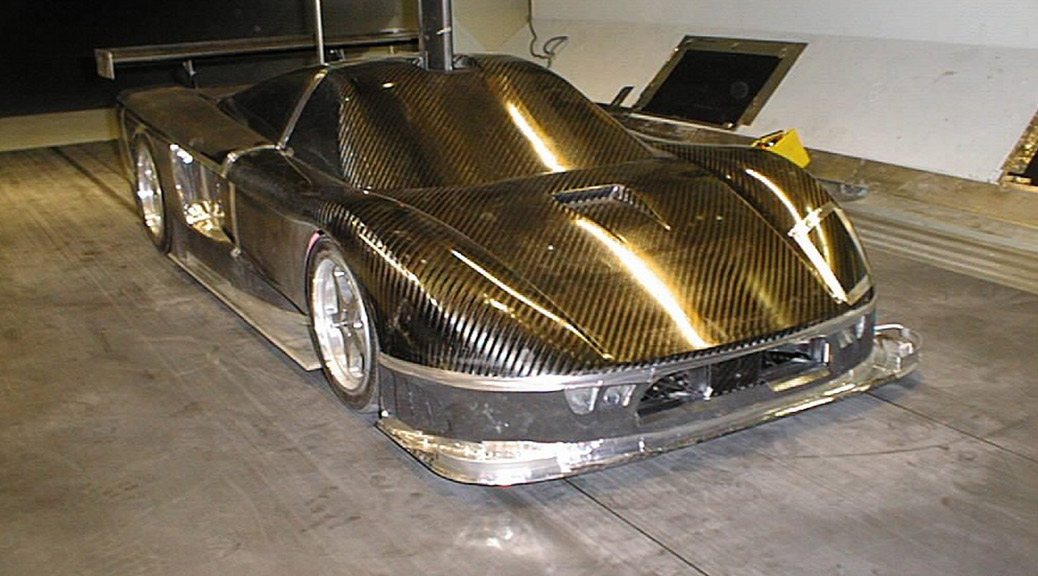By: AMY HIGGINS on March 1, 2001
Original Article: MACHINE DESIGN, VOL. 73, ISSUE 5
A space-age chassis and an engine fit for both racing and street cruising take Saleen’s “supercar” to new levels.
Zero to 60 in under 4 sec. A top speed North of 200 mph. Ground effects that would let the car cruise at 160 mph — upside down. Suffice it to say, the new S7 super car from specialty carmaker Saleen Inc., Irvine, Calif., would surely blow the doors off Herbie. Throw in sleek lines, smooth curves, and Delorean-style doors, and you’ve got one fine-looking ride that gives “supercar” a new meaning.
Incredibly, Saleen’s new beauty was designed, engineered, manufactured, and ready for delivery in just 18 months. But development wasn’t a one-man gig. Saleen worked closely with OEMs from around the globe including Italian brake manufacturer Brembo, British racing house, Ray Mallock Ltd. (RML), and a host of other specialty suppliers.
“Niche manufacturing is about using the best available from the world’s high-quality suppliers,” explains Steve Saleen, president and founder of Saleen Inc., “It’s a nontraditional way to build a car, but for small-volume manufacturing, it’s the most effective and efficient method to bring a quality car to market with minimal cost.”
In designing the supercar, the objective was straightforward: Design a vehicle that could easily compete with the fastest, most luxurious, and best-handling grand touring cars in the world, yet comfortably tool around on highways, autobahns, or country roads. The first step–a chassis and suspension fit for racing and street cruising.
Space-age chassis
Saleen tapped RML’s expertise in designing and engineering the S7’s futuristic chassis, suspension system, and overall look. RML built the preproduction chassis and body in Wellingborough, England, while the final prototype was assembled at Saleen’s plant in Irvine, Calif.
A lightweight steel, space-frame chassis is reinforced with a honeycomb-composite-carbon fiber that cuts weight but adds stiffness. Fully independent unequal-length “A” arms and lightweight aluminum dampers with coilover springs make up the basic suspension. Special CNC-machined aluminum uprights with a spider weblike structure direct cooling air to the brakes and wheel bearings.
Other components include specially tuned Brembo-supplied aluminum brakes: six-piston, 15-in. ventilated discs on the front, and 14-in. in the rear. Center hub-mounted wheels are shod with Pirelli P-Zero Rossa tires, size 275×30-19 upfront and 355×25-19 in back.
The S7 has a relatively large footprint with a 106-in. wheelbase and 68.75-in. front track. According to Saleen, the car’s presence is “amazing.” It stretches to 188 in. long and just over 78 in. wide. In true sportscar fashion, the S7 rides low, its body perched just 4 in. above the ground. At 41 in. high, it sits 3 in. lower than a Lamborghini Diablo, and at 2,750 lb, weighs 650 lb less. “We wanted a ‘form-follows-function’ look, but also one that was beautiful,” says Saleen. “I’d say we succeeded.”
Engineers also made safety a high priority. For starters, the S7 fuel tank sits at chassis center. This reduces changes to the car’s handling with fuel load, and improves overall packaging, says Saleen. A front-suspension antiroll bar, carbon-fiber rocker panels and doors, and three-point seat belts with automatic pretensioners add to the mix. Aluminum honeycomb panels add strength to the steel chassis and absorb impact. The same material makes up the front crush structure and rear crumple zones.
Built for speed
Powering the supercar is a 7-liter (427 in.3), normally aspirated, aluminum V-8 that generates 550 hp at 6,400 rpm and 520 lb-ft of torque at 4,000 rpm. Torque transfers to the rear wheels through a new-generation, six-speed transaxle.
Interestingly, the huge powerplant is just slightly over-square in that the stroke length is actually shorter than the bore size. Over-square engines are typically used in racing because they develop more power at higher rpm. On the other hand, they tend to lack torque at lower speed, which makes them less suitable for cruising down the highway. The S7 spans both worlds with a 4.125-in. bore and 4-in. stroke.
Though the S7 engine block is cast according to a traditional Ford design, Saleen completely reengineered it 8 in. shorter than the original block. A compact front engine accessory drive system with a side-mounted water pump streamlines the engine and helps distribute weight.
Further improving weight distribution and CG is a midchassis-mounted engine. This arrangement also allows for an especially tall “true” downdraft induction system. Here, air flows through a carbon-fiber air box leading to a magnesium throttle body and intake manifolds. Fuel feeds through matched trumpets in a straight shot to the intake ports.
The use of space-age materials makes engine components lighter and more reliable. Take the high-strength piston rods, for example. They are forged from a new EN40B billet steel. Beryllium exhaust valve seats effectively transfer heat away from the all-aluminum, CNC-machined cylinder heads. Stainless-steel valves and titanium retainers toughen the valve train. And a specially designed crankshaft is crafted from 4340 forged billet steel.
Yet another performance feature is Saleen’s dry-pump, oil-delivery system. The system cuts power-robbing viscous friction, improves ground clearance, and thwarts oil starvation in hard cornering. Innovation doesn’t end there. The S7’s huge muffler has a twofold purpose: It cuts noise and acts as part of the rear impact crumple zone. Surprisingly, the supercar meets all federal and California emission-control standards as a transitional low-emissions vehicle.
A true drag diffuser
Advantages gained in the wind tunnel are priceless, something not lost on S7 designers. They spent considerable time at Scotland’s University of Glasgow wind-tunnel facilities refining drag-to-lift ratio, center of gravity, drag coefficient, and downforce. With the S7, what you see is not all you get. Full underside body sculpting helps cut underbody turbulence and boost overall stability at high speeds.
Gills and fascia openings add to the S7’s exotic beauty while serving a functional purpose. For example, side scoops let air move through the vehicle to cool the transmission while split radiators exhaust under and to the sides of the car to produce downforce. A roof intake system supplies additional air to the engine, while a nose scoop helps ventilate the cabin.
Moving inside, creature comforts are as impressive as the exterior. Connolly leather upholstered seats and surfaces, air-conditioning, adjustable pedals, and a six-disc CD player are just a few of the features.
Tall drivers might find the S7 incredibly considerate to their plight with the removable steering wheel for easier entry, as well as an asymmetrical cockpit. Here, drivers sit more toward the center of the cabin than passengers, improving both visibility and weight distribution.
The supercar also sports a special, live-video rear-view “mirror” that uses a video camera concealed in the rear of the car and an LCD mounted where a traditional rearview mirror would sit. Analog gauges and a center-mounted tachometer are highlighted with brushed aluminum and body-color accents adding to the S7’s elegance.
Car enthusiasts lucky enough to get their hands on a 2001 Saleen S7 will pay handsomely. The supercar retails for $385,000. However, all hope is not lost for those with less dough. Saleen says it will build a less-expensive, higher-volume model to meet its goal of selling 300 to 400 cars worldwide through the S7’s four-year production run.

















